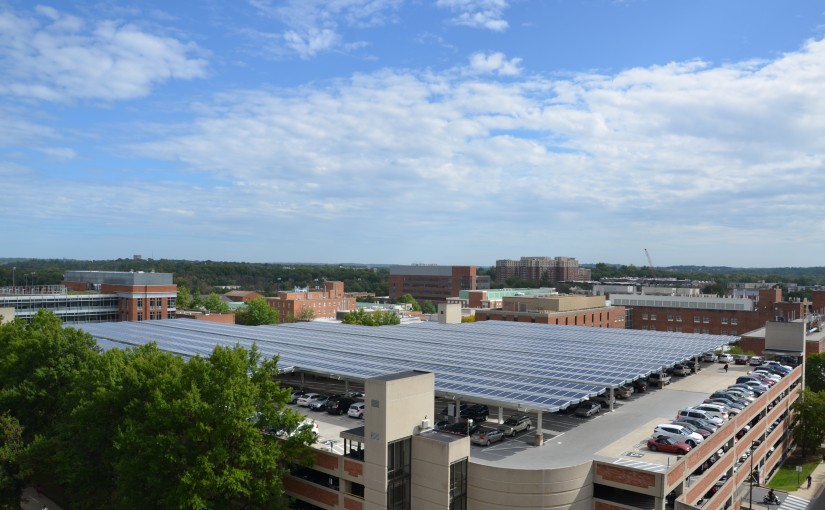The University of Maryland has made progress on several key sustainability initiatives, including increasing its compost collection, solar energy production capacity and education outreach, according to its 2017 Sustainability Progress Report.
This university is in the process of expanding its composting program, with more than 25 composting collection sites in operation, including in 12 dorms. Before this year, 11 dorms and about five academic buildings had composting.
The composting rate per person — calculated from Stamp Student Union’s mixed food and paper waste, the dining halls and other campus buildings — has increased about 450 percent since 2010, according to the report.
[Read more: A nonprofit ranked UMD the second-most sustainable Big Ten school]
Out of more than 1,500 tons of compost collected in 2016, most was taken from landscaping and the dining halls.
This is partly due to the Anytime Dining program, which “dramatically improved the sustainability of food service on campus by increasing local and ethically sourced food,” according to the report. This resulted in the removal of 6.3 million disposable items from the campus waste stream, which led to a 48-percent increase in dining hall compost collection.
The report also highlighted the new solar canopies, which were installed over the summer, on Regents Drive, Terrapin Trail and Mowatt Lane parking garages that are helping the university reach its goal of purchasing 100 percent of its power from renewable sources by 2020, said Sally DeLeon, a project manager at the Office of Sustainability.
[Read more: New weekly Terp Farm tours teach UMD students about sustainability]
The university currently receives 86 percent of purchased power from renewable sources, DeLeon said.
The report also highlighted the creation of two pilot programs — Green Terp for residential students and Green Chapter for Greek Life student — that encourage students to change part of their daily routines to be more sustainable, said Aynsley Toews, a project manager at the Office of Sustainability.
For example, students who sign up for the Green Terp program pledge to partake in 10 sustainable actions to get a certificate. These can include carrying a reusable water bottle, eating vegetarian one day a week or turning off the tap water when brushing your teeth.
“We always think sustainability is creating green buildings or driving fuel-efficient cars, but engineering and technology can’t save us from our own behaviors,” Toews said. “You might live in a energy efficient residence hall or house, but if you leave the heat turned up when you aren’t there or the window open, you aren’t seeing the true efficiency of that building.”
During their launch in spring 2017, the programs exceeded their goals of reaching 25 percent of the student population in two dorms and four chapter houses, with almost 300 students signing up.
This semester, the pilot has expanded to include nine chapter houses and 13 dorms, Toews said.
For the Green Terp program, about 1,000 students have signed up this semester so far. The goal is to expand the program to all students on campus, Toews said.
This university also launched the Maryland Energy Innovation Institute earlier this year with $7.5 million in state funding. The institute’s goal is to enhance clean energy research programs at academic institutions in Maryland and develop private investment in clean energy innovation and commercialization projects, according to its website.
“Through the institute, we’re trying to extend the research and sustainability efforts that are going on at this university,” said Eric Wachsman, director of the institute and part of the University Sustainability Council. “The goal is to develop and commercialize technology with a much broader impact than what is going on at the campus itself.”
Although this university has made a lot of progress, DeLeon said there’s still ways this university can improve.
There has been a 63 percent increase in air travel emissions since 2009, which made up about one quarter of this university’s transportation emissions in 2016, according to the report, and campuswide water consumption has increased as well.
“We can’t let our guard down,” DeLeon said. “We have ambitious goals but we can reach them as long as we stay connected and work together. Every contribution, however small, does have an impact across campus.”



